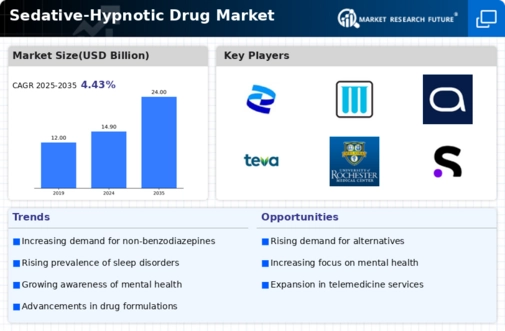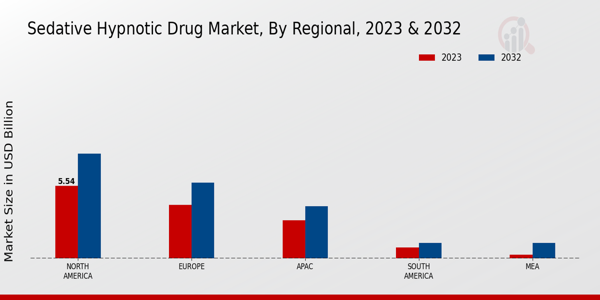Aging Population
The global demographic shift towards an aging population is another crucial factor influencing the Global Sedative-Hypnotic Drug Market Industry. Older adults are more susceptible to sleep disorders and related health issues, which increases their reliance on sedative-hypnotic medications. By 2035, the proportion of individuals aged 65 and older is projected to rise significantly, further driving the demand for these drugs. This demographic trend suggests that the market could expand to 24.0 USD Billion by 2035, with a compound annual growth rate (CAGR) of 4.43% anticipated from 2025 to 2035. The need for effective management of sleep-related conditions among the elderly population is likely to shape market dynamics.
Market Growth Projections
The Global Sedative-Hypnotic Drug Market Industry is projected to experience substantial growth over the next decade. With a market value expected to reach 14.9 USD Billion in 2024 and 24.0 USD Billion by 2035, the industry is on a trajectory of expansion. The compound annual growth rate (CAGR) of 4.43% from 2025 to 2035 indicates a robust demand for sedative-hypnotic medications. This growth is driven by various factors, including the rising prevalence of sleep disorders, an aging population, and increased awareness of mental health issues. The market dynamics suggest a favorable environment for stakeholders, including pharmaceutical companies and healthcare providers.
Regulatory Support and Approval
Regulatory support and streamlined approval processes for sedative-hypnotic drugs play a pivotal role in shaping the Global Sedative-Hypnotic Drug Market Industry. Governments and health authorities are increasingly recognizing the importance of these medications in treating sleep disorders and mental health conditions. Initiatives aimed at expediting the approval of new drugs can enhance market accessibility and foster competition among pharmaceutical companies. This supportive regulatory environment may lead to a broader range of available products, ultimately benefiting patients. As a result, the market is poised for growth, with an anticipated increase in the number of approved sedative-hypnotic medications.
Rising Prevalence of Sleep Disorders
The increasing prevalence of sleep disorders globally is a primary driver of the Global Sedative-Hypnotic Drug Market Industry. Conditions such as insomnia and sleep apnea affect millions, leading to a heightened demand for effective treatment options. According to health statistics, approximately 30% of adults experience sleep disturbances, which propels the need for sedative-hypnotic medications. This trend is expected to contribute significantly to the market's growth, with projections indicating that the market will reach 14.9 USD Billion in 2024. As awareness of sleep disorders continues to rise, the industry is likely to see sustained demand for these therapeutic agents.
Advancements in Pharmaceutical Research
Innovations in pharmaceutical research and development are propelling the Global Sedative-Hypnotic Drug Market Industry forward. The introduction of novel compounds and formulations that offer improved efficacy and safety profiles is likely to attract both healthcare providers and patients. Recent advancements have led to the development of medications with fewer side effects, enhancing patient compliance and satisfaction. As the industry continues to evolve, these innovations may result in increased market penetration and growth. The ongoing research efforts are expected to create a more diverse product portfolio, catering to various patient needs and preferences, thereby driving market expansion.
Increased Awareness and Acceptance of Mental Health
Growing awareness and acceptance of mental health issues globally contribute to the expansion of the Global Sedative-Hypnotic Drug Market Industry. As society becomes more open about discussing mental health, individuals are more likely to seek treatment for anxiety, depression, and related disorders, which often require sedative-hypnotic medications. This cultural shift is reflected in healthcare policies that prioritize mental health, leading to increased prescriptions of these drugs. The market's growth trajectory is expected to be positively impacted as healthcare providers recognize the importance of addressing mental health, thereby enhancing the overall demand for sedative-hypnotic therapies.













